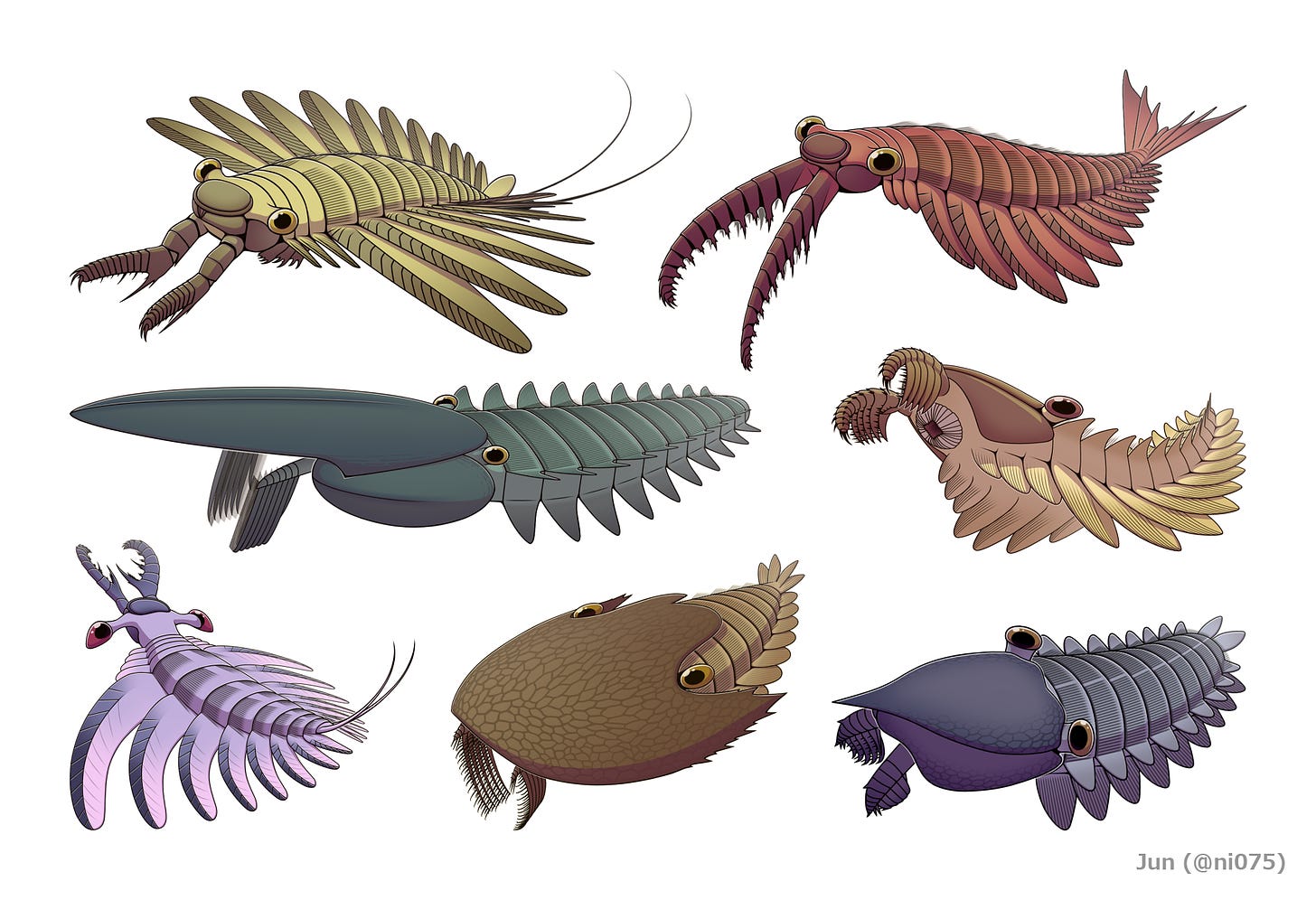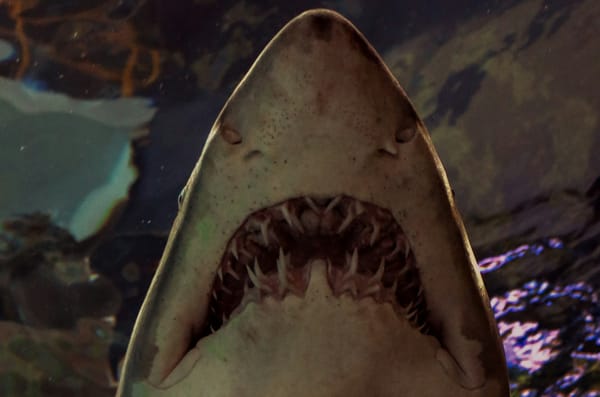The Frog Pond #12: I'm Not Like Other Shrimps (I'm enormous)
Or, Anomalocaris deserves more love.

It’s been a year of Frog Pond! And in that time we’ve covered everything from aluminum to subterranean forests to the legend of meat rain.
With a new year comes change. To keep the Frog Pond a sustainable monthly newsletter, I’m concentrating it down to its best parts; the weird and the writer-ful.
Without further ado, let’s talk abnormal shrimp!
Radiodont miss this cool shrimp
Anomalocaris (which means “unlike other shrimp”1 or “strange shrimp”2) of the class Radiodonta needs more love! Not only is this genus of 13 species34 one of the earliest apex predators ever (evolving in the Early Cambrian period up to 520 Million years ago5) but they were also among the largest at the time at up to 1.25 ft, or 38 centimetres, long6.
Keep in mind that the Early Cambrian (or Cambrian Stage 2) period is defined with the first appearance of trilobites, measuring in the millimetres7. Anomalocaris was something incredibly different during a time when anything that wasn’t stuck on the seabed or still unicellular was only just beginning to evolve.
Imagine if you crossed an elephant with a shrimp with a flying carpet and you’re probably not far off.

Misunderstood giants
Fossils of Anomalocaris have a long history of misidentification. Bits and pieces of their fossils were attributed to different animals until they were eventually combined to show the full, strange picture of this ancient anthropod8. Anomalocaris has been mistaken for a jellyfish, a crustacean, other extinct forms of anthropods, and even sea cucumbers9.
In fairness to early paleontologists, this is not exactly a creature that would be easy to piece together if you didn’t already know what it looked like and were only working off of fragments of preserved imprints.
It wasn’t until 1966 when all the pieces came together through a comprehensive revision of the Burgess Shale fossil record, a review of what had been found in the Canadian Rockies of British Columbia10.
And it wasn’t until 2011 that the compound eyes (the ones found on animals like flies and crabs) were recovered from a specimen in Australia, proving that Anomalocaris was an arthropod11.
Species of Anomalocaris are still being discovered as of 2023, while others have been reassigned to other genus and families12. Who knows what else we’ll learn about this flexible, funny-looking lethal predator of the ancient ocean!
The reason trilobites roll?
There’s some debate over what Anomalocaris ate and how. Some believe that its frontal appendages (those segmented trunk-looking… things) were strong enough to crack through the tough armour of trilobites, while others believe that they exclusively hunted soft-bodied prey13. Because Anomalocaris had no mineralized tissue (an exoskeleton shell) it’s unlikely that they would be able to penetrate the hard, calcified shells of trilobites14.
One theory suggests that Anomalocaris used its frontal appendages to rock trilobites back and forth to get to their soft underbellies. This could be an evolutionary pressure that made trilobites develop the behaviour to “roll up”, like a modern day pill bug15, to protect themselves.
Ancient ocean creatures are wonderfully bizarre, and Anomalocaris might take the cake for me (though there are plenty of ancient cephalopods that are also wonderfully weird). I learned some of the above from a recent documentary on Netflix, Life on Our Planet. While the style wasn’t 100% my speed (I agree with a lot of points brought up by the linked Guardian review), it was still a fun series about the various animals that lived during periods of huge expansion and extinction over the last 4 billion years.
A word from a passing frog
I hope you had a safe and your-candy-of-choice-full Halloween! My favourite are Reece’s, but Aero is high up there too! And if you’re participating in NaNoWriMo, good luck this month!
Life
I had a busy October, especially this last weekend when I got to stand for a wedding with family very close to my heart. I laughed, cried, and danced with friends from all over the country (and world!) and my voice still hasn’t quite recovered!
November has even more to offer, with NaNoWriMo starting, a trip for my SO to officially graduate with his PhD, and the most exciting: We’re going to adopt a cat!! We’ve wanted a cat for years, but life/money/apartments haven’t lined up. I’m so excited to share our home with a furball!
Writing
I’ve finished my first edit round with my agent! I was nervous to get back into my maritime gothic horror book, but I had a blast. I think there are books you write to learn and grow, and books you write out of passion, and I’m lucky that this book lives in the middle of both.
While I’m waiting for the next round of edits, I’ll be working on a “just for fun” book as a “light” NaNo. I use air quotes on both of those because I know who I am and neither just for fun or light ever accurately describe my writing process.
The current book, nicknamed Apothecary, is a fantasy dark academia book about a daughter of herb witches without magic of her own who journeys across the continent to Hemlock College to study other forms of magic and continue her family’s apothecary. Along the way she befriends a warlock attempting to sign a union contract with her patron and a young vampire more interested in climate activism than hunting humans. It’s been so fun to outline this book, which has somehow morphed into a duology already, with influences from Dimension 20’s Fantasy High, BABEL, and some personal life experience.
Reading
I listened to seasons 3 & 4 of The Magnus Archive (and half of 5 but I had to take a break from the darker episodes) and read Gideon the Ninth by Tamsyn Muir.
I’m currently reading Starling House by Alix E. Harrow and I’ve got I Feed Her to the Beast and the Beast Is Me by Jamison Shea on loan to read next. It’s not looking great for my GoodReads challenge (I’m 6 books behind right now), but I’ll keep trying!
A final note: If you’re looking for ways to support healthcare for Palestinians, there’s a great video game collection on itch.io that’s raising funds for Medical Aid for Palestinians, a well-regarded non-profit in operation since 1982 and recognized by the United Nations Economic and Social Council since 2002. The Games for Gaza bundle have over 250 games, TTRPGs, books, and other cool indie media all for a donation of $10 or more. Check it out here!
I also recommend checking out Books for Palestine, a book auction from November 7 to 11 to educate, advocate, and fundraise for Palestine Children’s Relief Fund, Adalah Justice Project, and Palestine Write.
Footnotes
1
2
3
https://www.tandfonline.com/doi/full/10.1080/14772019.2023.2225066
4
https://ui.adsabs.harvard.edu/abs/2021PPP...569k0333W
5
http://www.geology.cz/bulletin/fulltext/1442_Lerosey-Aubril.pdf
6
7
https://en.wikipedia.org/wiki/Small_shelly_fauna
8
https://www.worldcat.org/title/18983518
9
https://www.worldcat.org/title/18983518
10
https://ui.adsabs.harvard.edu/abs/1996JPal...70..280C/abstract
11
12
https://www.tandfonline.com/doi/full/10.1080/14772019.2023.2225066
13
https://www.academia.edu/1517990
14
https://ui.adsabs.harvard.edu/abs/1999Geo....27..987N/abstract
15
https://ui.adsabs.harvard.edu/abs/1999Geo....27..987N/abstract





